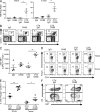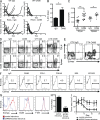Induction of tumoricidal function in CD4+ T cells is associated with concomitant memory and terminally differentiated phenotype
- PMID: 23008334
- PMCID: PMC3478933
- DOI: 10.1084/jem.20120532
Induction of tumoricidal function in CD4+ T cells is associated with concomitant memory and terminally differentiated phenotype
Abstract
Harnessing the adaptive immune response to treat malignancy is now a clinical reality. Several strategies are used to treat melanoma; however, very few result in a complete response. CD4(+) T cells are important and potent mediators of anti-tumor immunity and adoptive transfer of specific CD4(+) T cells can promote tumor regression in mice and patients. OX40, a costimulatory molecule expressed primarily on activated CD4(+) T cells, promotes and enhances anti-tumor immunity with limited success on large tumors in mice. We show that OX40 engagement, in the context of chemotherapy-induced lymphopenia, induces a novel CD4(+) T cell population characterized by the expression of the master regulator eomesodermin that leads to both terminal differentiation and central memory phenotype, with concomitant secretion of Th1 and Th2 cytokines. This subpopulation of CD4(+) T cells eradicates very advanced melanomas in mice, and an analogous population of human tumor-specific CD4(+) T cells can kill melanoma in an in vitro system. The potency of the therapy extends to support a bystander killing effect of antigen loss variants. Our results show that these uniquely programmed effector CD4(+) T cells have a distinctive phenotype with increased tumoricidal capability and support the use of immune modulation in reprogramming the phenotype of CD4(+) T cells.
Figures






References
Publication types
MeSH terms
Substances
Grants and funding
LinkOut - more resources
Full Text Sources
Other Literature Sources
Molecular Biology Databases
Research Materials

